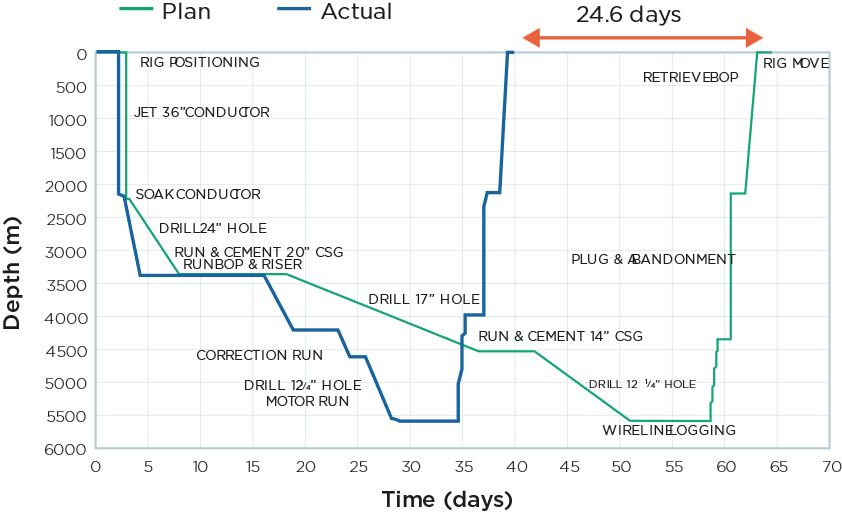
Location
- Gabon, West Africa
- Ultra deepwater
Challenge
Show that real-time rate of penetration (ROP) optimization can signifi cantly contribute to improving ROP, decreasing drilling time and reducing costs, even when an auto driller is used.
Solution
The agent was used by RTO engineers to provide the rig crew with real-time drilling parameter recommendations for optimizing the ROP.
Results
Following the recommendations of the real-time ROP optimization agent, the operations team was able to adapt quickly to changing lithologies, and observed continuous improvement of the drilling performance.
Products Used
Ultra-deepwater exploration drilling is exceptionally costly, and calls for meticulous well design and equipment selection. When Petronas was embarking on an ultra-deepwater project in West Africa, they looked to Exebenus to provide real-time drilling optimization technology. Using the Exebenus Current ML™ Real-Time ROP Optimization agent, Petronas was able to reduce drilling time and ultimately outperform the project’s authorization for expenditure and technical limits.
Optimize operations time, drive costs down
Petronas was planning an ultra-deepwater exploration well that was pivotal to its offshore West Africa operations. Because of the 2,100 m water depth, Petronas contracted a modern, high-spec ultra-deepwater drillship equipped with an auto driller and dual derrick to reduce the time spent on the well as much as possible.
Ultra-deepwater operations typically run at least $800K USD per day, and with every minute of downtime, the clock ticks in the thousands of dollars.
The operator was determined to minimize operation time, push the equipment to its technical limits, and keep downtime to an absolute minimum. Offset wells drilled in the area had experienced vibration in the 12 1/4 in section, resulting in reduced ROP. An earlier 6 5/8 in section drilled with a positive displacement motor bit showed an average on-bottom ROP of 16 m/hr.
ROP optimizer improves on already optimized plan
The Petronas well engineering team put considerable effort into setting drilling parameters that would maximize the ROP within safe operating limits. The Exebenus Spotter ML Real-Time ROP Optimization agent was chosen to further optimize the operation.
The agent was set up in the real-time operations (RTO) center. The RTO team monitored the drilling parameter recommendations provided by the agent, and communicated recommendations to the rig drilling supervisor regarding RPM, weight on bit (WOB) and mud flow rate. Both the RTO and drillship operations center teams monitored the effect of the recommendations on the actual ROP.
The team also ran Exebenus Spotter ML stuck pipe agents, paying particular attention to indicators related to hole cleaning. The operator established guidelines for communication between the RTO and the rig to ensure that the moment-to-moment decision making power and responsibility remained in the hands of the rig team. The RTO relayed the advice of the optimization agent to the rig only when the recommended drilling parameters would
significantly increase the ROP, and only when the advice did not pose any risk to equipment or operational safety.
The agent provides updated recommendations on drilling parameters every 50 cm of drilling, but to comply with the guidelines, the RTO advised on changes in drilling parameters only two or three times per stand, then based on trends in the recommendations.
During the first 10-hour drilling interval, the recommendations were only followed sporadically. In this interval, the ROP was between 20 m/hr to 40 m/hr. During the next 12 hours of drilling, the rig followed the WOB and RPM optimization advice and the ROP increased to between 40 m/hr and 60 m/hr. Yellow line shows the two intervals.
Increased ROP reduces drilling time and cost
The results of using the ROP optimization agent were impressive. The added value of the agent was especially notable given the extensive well engineering that had gone into this well and the use of an advanced rig equipped for the best possible performance.
The project finished 24.6 days ahead of authorization for expenditure and 2.4 days ahead of the expected technical limits. No nonproductive time related to drilling was experienced.
There were clear increases in ROP when optimized parameter suggestions were followed, even with the auto driller installed on the drillship and drilling performance reaching the perceived optimum. The on-bottom ROP was significantly higher than that of the offset wells drilled in a comparable formation.
The agent also proved to be beneficial in ROP benchmarking and in identifying potential improvement opportunities for future well planning.
The machine learning model for the ROP optimization agent was used out-of-the-box without customized training. The successful application of a generalized model opens up a new frontier for machine learning in drilling operations. Reducing and eventually eliminating human input in model architecture will bring the industry one step closer to drilling automation.
The Time Depth plot shows how the optimization agent used in the exploration operation contributed significantly to reducing operational time.

